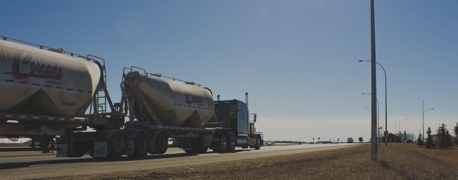Can Truck Drivers Say No to Driving in Bad Weather?

According to a 2017 study performed by the Occupational Safety and Health Administration (OSHA) and Federal Motor Carrier Safety Administration (FMCSA), there were approximately 450,000 accidents involving large trucks that year. Although the causes of these accidents were not reported, winter weather plays a significant role in making the roads more dangerous for all vehicles, especially large tractor-trailers.
Do Truck Drivers Have to Drive in Bad Weather?
Because truck drivers are responsible for determining whether their rig is ready for a trip each time they get on the road, it stands to reason that they have control over deciding whether it’s safe to drive in any weather. Although there are several ways a trucker can prepare for safe winter driving, sometimes the risk isn’t worth it. If the road is too slick or the snow is too heavy, a truck driver may want to pull over and wait out the storm or wait until the roads have been plowed and salted.
In fact, the Surface Transportation Assistance Act (STAA) specifically prohibits employers from discriminating against commercial drivers, including truck drivers, for refusing to drive in what they deem to be unsafe conditions. Should the employee be forced to drive in dangerous weather, for example, or be fired for saying no, they may seek legal action.
Specifically, according to the law, “A person may not discharge an employee, or discipline or discriminate against an employee regarding pay, terms, or privileges of employment, because… the employee has a reasonable apprehension of serious injury to the employee or the public because of the vehicle's hazardous safety or security condition.”
Are Truck Drivers Liable for Accidents?
Regardless of whether you, a coworker, or your employer is at fault, you have a right to compensation for injuries suffered on the job. If the accident happened during work hours, the legal principle of respondeat superior tends to apply, meaning that the employer is responsible for the truck driver’s actions while their scope of work is being performed.
However, the legal principle of ignorantia juris non excusat (ignorance of the law excuses no one) also applies.
This means that a truck driver can be held personally liable for an accident in these situations:
- When working as an independent contractor
- When acting deliberately
What Safety Inspections Are Required to Operate a Truck?
Truck safety starts with the vehicle itself. Every time a truck gets on the road, the owner of the vehicle is responsible for making sure it is safe to operate. A thorough, annual inspection must be performed by the owner (most often the employer), while pre- and post-trip inspections are the responsibility of the truck driver, according to rules laid out in FMCSA Part 396.
To ensure the safety of a truck driver and the people they share the road with, preventative roadside inspections may occur at any time. The varieties of these are comprehensive; a truck driver may be subject to any of 8 levels of DOT inspections. Truck drivers must always be prepared for any of the 8 DOT Inspection levels, which include:
Level I: North American Standard Inspection
This is a 37-step process that examines the driver and vehicle thoroughly.
Level II: Walk-Around Driver and Vehicle Inspection
Similar to Level I, this only includes items that can be inspected without getting under the truck.
Level III: Driver-Only Inspection
This includes items related to the driver, including license and seat belt.
Level IV: Special Inspection
This is a one-time examination of a specific item, often in response to a suspected trend.
Level V: Vehicle-Only Inspection
This is an inspection of all the vehicle-specific items on the comprehensive list in Level I.
Level VI: NAS Inspection for Transuranic Waste and HRCQ (Highway Route Controlled Quantities) of Radioactive Material
This is an inspection of specific radiological shipments, and may include enhancements to Level I. A special symbol is used to notate which vehicles meet the Level VI criteria and is only valid for one trip.
Level VII: Jurisdictional-Mandated Commercial Vehicle Inspection
This inspection typically applies to commercial vehicles such as school buses, rideshare transportation, and hotel courtesy shuttles.
Level VIII: North American Standard Electronic Inspection
This is a roadside inspection conducted electronically while the vehicle is in motion. The list of data points required for a Level VIII inspection is extensive, including:
- GPS coordinates
- Validation of the vehicle’s operator
- Driver’s license class
- License status
- USDOT number
- Medical examiner’s certificate
- Skill Performance Evaluation (SPE) certificate
- Record of duty status
- Hours of service compliance
- Unified Carrier Registration compliance
- Power unit registration
- Operating authority
- Federal out-of-service orders
As a truck driver, you understand what it takes to operate your rig safely. If you feel that it’s too risky to get on the road during a storm, you should be able to contact your dispatcher to delay the delivery.
If you have been injured in a truck accident, Arnold & Itkin can help. We have helped survivors and families just like you secure their future. Contact us today at (888) 493-1629.


